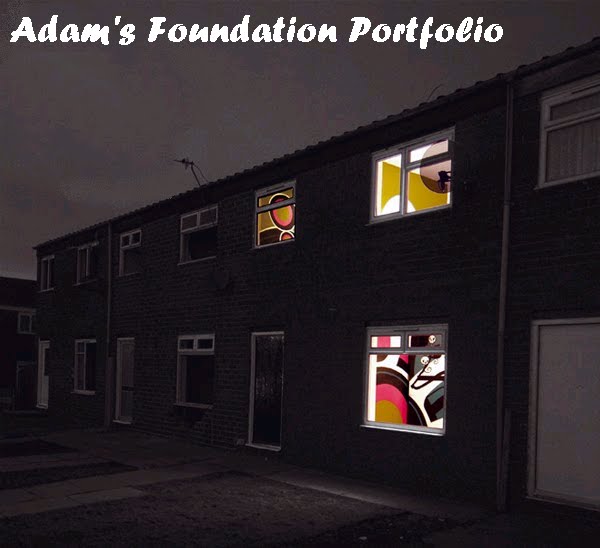four quadrant- a film which applies to most ages/ genders
niche- a market with selective people within it
35mm - 35mm reels used for films
convergance- the working together of
encryption codes- help prevent piracy
escapism- were a film allows the audience to "escape" from reality
realism- were a film ha social realism
merchandising - when a film sells products which are from the movies e.g. keyrings
streaming - through technology
above the line/ below the line- above is were you cant help see it , below the line has to be looked for
synergy- a business uses the success of another to promote itself
viral- word of mouth
product placement- a branded product is placed within a movie
vertical/horizontal integration - vertical own distribution comapny , horizontal dont
conglemarate- a institution with a large market share
DSN sites - digital screen network , alternative to 35 mm reels
distribution - when a film is distributed to a distirubter
exhibition- were a film is shown e.g. leicester square
Lord Puttnam- the theory of star persona not mattering
Shane Meodows- uses pre-fabricated sets aswell as cutting down on costs
Wednesday, 12 May 2010
Wednesday, 28 April 2010
Monarch of The Glen Key Words
Key words from Monarch Of The Glen
Stereotypical representation
establishing shot
long shot
high/low angle
middle aged
young
old teenager
childish
father figure
binary opposite
enigma
country style clothing
superiority
Stereotypical representation
establishing shot
long shot
high/low angle
middle aged
young
old teenager
childish
father figure
binary opposite
enigma
country style clothing
superiority
Sunday, 25 April 2010
How is the representation of disability constructed in this extract?
The idea of disability in this extract is constructed in such a way as to elicit a certain degree of sympathy from the audience. However, it is not as simple as presenting the main character as extremely vulnerable, as is often the case when disabilities are stereotyped. Instead, empathy is elicited by displaying a normal working-class bloke, one which a vast majority of people would be able to relate to. He talks normally, using oft-heard midlands accents, proverbs and colloquialisms, such as 'hoping i could have me old job back and that'. At the beginning he acts as if nothing had happened, although his friend was giving him dodgy looks. This again highlights his normality - giving the audience the feel that he could be one of us. The clip begins by emphasising the effects of his new disability, the difference between past and present - the past being when he had his job before and the present when he tries to get his job back.
Thursday, 22 April 2010
Cameras n HD
Theres a big difference between using 16mm and HD. For the purposes of making a movie, even 16mm film has better 'resolution' than all but the most expensive HD cameras. When it comes to rental costs, HD equipment (especially the decks) can be a lot more expensive than film equipment. But tapes (or hard drives) are cheaper than film (purchase and developing costs). You have to weigh the expense of developing film against how much footage you plan to shoot. If you want to end up with a film print that can be projected (there are still too few digital projectors out there, although a lot of major festivals now have at least one), you'll have to pay an expensive blow-up cost to transfer your final digital cut to film. In most cases, it won't look as nice as it would if you'd shot on film in the first place. Some movies shoot on film and finish to HD. But assuming that you only want to sell your movie to the HD TV channels and sell on DVD and the Blu-Ray, HD is beginning to make good business sense. It takes a rare filmmaker to give up on seeing his or her masterpiece on film. But when a theatrical release isn't in the cards, HD is the optimum choice.
Because it's so expensive, movies like Dead Man's Shoes will not use HD as they work on a lower budget and the benefits will be low.
High End Camera equipment - RED one is aimed to be a highly-flexible camera thats capable of high end imaging.
Because it's so expensive, movies like Dead Man's Shoes will not use HD as they work on a lower budget and the benefits will be low.
High End Camera equipment - RED one is aimed to be a highly-flexible camera thats capable of high end imaging.
Friday, 16 April 2010
What kind of media institution might distribute your media product and why?
My film is a thriller, which is aimed at a broad age range of males, mainly aimed towards the rural working-class but includes flashbacks of children and snapshots of everyday British life, which will also appeal to females. Mine is an independent film, which by definition means that less than half of the budget is paid for by major film companies.
Being an independent film we would begin by filming the sequence and some footage with a very home-made feel to it. We would then appeal to the UK film council for funding or grants, as well as appealing to the government for use of tax breaks such as s. 42 and s.48, which have the power to write off production costs to films with a budget of under 15,000, or to postpone the payment for 3 years for films of any budget respectively. Other funding might be found by appealing to the City of London for Equity investment or searching around for Gap financing and Below-the-line investment , for example from other countries.
My company is an independent film company – Shotgun Films, and through this I would try to keep the process vertically integrated, which is the practice of keeping the production, distribution and marketing within the one company as much as possible. Independent films have become much more popular over the last ten/fifteen years in the postmodern era, and so the fresh interest will hopefully sell films. However, if i was to use another company to distribute my film i might make a deal with a company such as Palisades Tartan, who have a reputation of producing and distributing thrillers and horrors.
A large part of my marketing and distributing will be about networking, building a viral buzz to sell the film. The film will utilise the internet as much as possible, in a way similar to Paranormal Activity – it will begin with creating websites, and using social networking sites such as Myspace and Facebook to increase awareness and create enigma.
Thursday, 15 April 2010
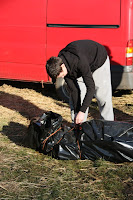

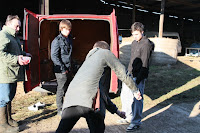
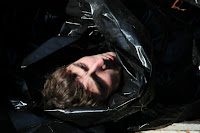
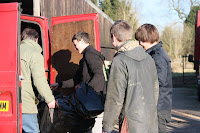
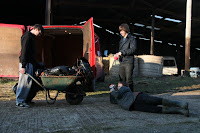
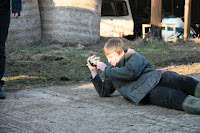
These are some of the shots i took of us filming. It was good fun, and i learnt a lot about how to use a camera as well as a tripod. I learnt how to shift the focus in and out, how to manipulate tapes to find the right place to film, how to find good angles to film from, as well as how to be strict on keeping things in continuity. All these very fine details may seem insignificant but are actually the most important, these are the difference between a pleasing film and a shoddy film.
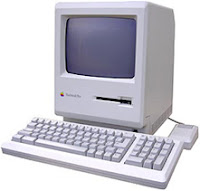
We used the iMovie program on Apple Macs to create our movies.
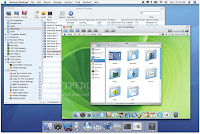
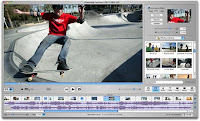
Looking back at your preliminary task (the continuity editing task), what do you feel you have learnt in the progression from it to full product?
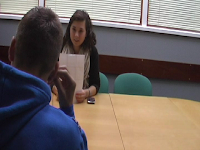
This simple shot-reverse-shot isn't the most effective - we cannot see Giorgio's expression as he puts his earphone in, and the shot is almost too long to retain interest.

Again, a very simple shot showing what Nicky is writing, the camera zooms in a little too far as well - these are important details that would be edited out in a professional film.
Simple long shots for the beginning, as well as a match-on-action when Giorgio opens the door, simple high-angle tilting shot to give the impression of a greater intelligence looking down on them. We have a simple shot-reverse-shot then, before a basic high-angle shot zooming into Nicky's writing. We kept to the 180 degrees rule by not filming from the other side of Giorgio and Nicky in the shot-reverse-shot.
My final movie, however, utilises a variety of shots. The sequence begins with an extreme long shot, cuts to a close-up over the shoulder, displaying a low-angle shot, before showing a panning shot of the sky. Already, i have four kinds of shot that i didn't use in the prelim. I have tried to include a variety of angles, so we have a couple of high-angle shots, as well as some floor shots -
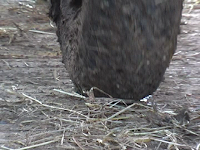
I have also included effects for good measure, such as the black and white film effect.
Wednesday, 14 April 2010
Who would be the audience for your media product?

My target audience profile is for Dan, 18. He is a working class lad who has left school to work at a butcher's shop. He visits the pub every thursday, friday and saturday, plays football for his village team and is dating a local girl, who he goes to see a film with most fridays, preferably to watch action, crime or thriller films. He enjoys listening to Radio 1 but listens to mainly Rock preferring typical masculine 'lad-rock' type bands such as Kasabian, Oasis, Arctic Monkeys and The Enemy. He shops at G-star raw, All Saints and River Island, but varies his clothes depending on the fashion and prices of the moment. He grew up on films like James Bond and is attracted to the dangerously cool aesthetic of darker films with an edge to them. His sense of humour matches this; he is generally unimpressed by american comedy films such as American Pie, preferring the darker black humour of films such as Snatch.
How does your media product represent particular social groups?




My media product represents two particular social groups, or should i say the typical social dynamic of the duo. Above we have Matt, the loyal workhorse, bulky and strong but mentally weak and happy to follow orders. He follows legions of similar stereotypes that have played one half of polar opposites; following the likes of Hassan - the loyal childhood friend in the Kite Runner - Lenny, the giant in 'Of Mice and Men', and Pumbaa, from the Lion King.

Whereas, above, we have Adam, who plays the contrasting character - Amir to Hassan, George to Lenny, Timon to Pumbaa. In a way, this limits the 'bullseye' - the target audience that the piece is aimed at. Because we only see the characters of two boys of a similar age group and shots of three young boys, the sequence limits the film almost exclusively to males - there are no females even in the periphery of the sequence.
Tuesday, 13 April 2010
In what ways does your media product use, develop or challenge forms and conventions of real media products? (i.e. of film openings)

I have entitled my film 'Brothers in Arms', which is a reference to the Dire Straits song , but it also describes the three friends who grow up together in the film, who are now 'in arms'. The title suits the feel of the sequence also: it is sombre and unassuming. I wanted to use a very simple font, because the independent feel to the film necessitates minimalism: the stripped-down, 'Less is More' approach. In keeping with this ideal, i adopted a white-on-black colour scheme for the title - i felt other colours would clutter the eye. For the Setting of the film i chose my own farm because this was central to the whole idea of the film - it is based around 'rural decay' and the idea that life can be much more free in the country than the city. This challenges the conventional concept of the countryside being a place solely for rearing animals and growing crops, and along with this the stereotypical idea of the country bumpkin. My film also has a thriller edge to it, with the idea that very little information is given away at the beginning and revealed as the film goes on. The sole individual product that most influenced my film would have to be Dead Man's Shoes, although Snatch and Kidulthood also had their influences.
Monday, 12 April 2010
Tuesday, 23 March 2010
Mise en scene
I want my film to have a independent, gritty feel to it, in a similar vein to Dead Man's Shoes
, This Is England, Snatch, and other great films that expose the grittier, decaying side of working class England. I have come up with the term 'Rural decay' which is in a similar vein to Urban Decay but instead represents the many dilapidated shacks and farms that have been abandoned in the countryside. Part of the idea is that you can get away with whatever you want: -to use a cliche- 'noone can hear you scream'. If i was to make the film, i'm sure one of the taglines on the adverts would be: "If a man dies... [shot of finger pulling trigger] and there is noone...[camera zooms out, revealing a vast panoramic view] around to hear it... [shot of killer covering body in woods, continuing with his life as if forgotten, cut to cityscape of people going about their lives] did it even happen at all?
A good example of the type of feel i want my film to have is given off in this Libertines video, even though this is set in the city as opposed to the country:
, This Is England, Snatch, and other great films that expose the grittier, decaying side of working class England. I have come up with the term 'Rural decay' which is in a similar vein to Urban Decay but instead represents the many dilapidated shacks and farms that have been abandoned in the countryside. Part of the idea is that you can get away with whatever you want: -to use a cliche- 'noone can hear you scream'. If i was to make the film, i'm sure one of the taglines on the adverts would be: "If a man dies... [shot of finger pulling trigger] and there is noone...[camera zooms out, revealing a vast panoramic view] around to hear it... [shot of killer covering body in woods, continuing with his life as if forgotten, cut to cityscape of people going about their lives] did it even happen at all?
A good example of the type of feel i want my film to have is given off in this Libertines video, even though this is set in the city as opposed to the country:
Wednesday, 17 March 2010
This clip explores the twin issues of gender and ethnicity in a number of ways; the first and foremost issue is that of the Irish working class man. We can clearly hear his irish accent and we immediately see he has been beaten up. We also hear that he has been wrongly accused, which presents the Irishman as possibly being a victim of racism. He also refers to his father moving to England and being abused, indicating a history of it as well - much of the hurt caused by racism is magnified if it is longstanding. He makes a reference to the Irish being given all the labouring jobs that the english don't want to do: "Shovelling shit" he calls it, and his rough clothing verifies this. There is also the mentioning of the asian woman's sari as a 'nighty' - it could be interpreted as a misunderstanding, but more likely, Gene is making a racist joke. This is, from what i can gather, a decent representation of men's attitudes to discrimination in the '70s. It was often seen as comical; a good example would be Alf Garnett:
There is also examples of sexism: the reference to a woman prime minister was met by derisive laughter from the other officers, indicating an inability to respect women.
Thursday, 11 March 2010
The Soloist
The Soloist was actually filmed in the Skidrow area of Los Angeles itself, with the camera crew working with the homeless in order to achieve a realistic effect and to create a sense of pride in their work. The movie was created when the producer discovered a number of columns written about a homeless guy called Nathaniel, and decided to make a film about it. Jamie Foxx, who played Nathaniel, spent some time with him in order to get a feel for the part, to copy his speech patterns and create the image of a schizophrenic dude. The film company also pulled in a chinese guy who could play good cello, and taught him using his own system. The director's aim was to help to break down the stigma surrounding the homeless.
Friday, 5 March 2010
Pitch
A thriller with elements of black comedy, focusing on teenagers using a prefabricated set of rural decay. Dead Man's Shoes meets Snatch and Kidulthood.
Thursday, 4 March 2010
The Soloist
The release date for the Soloist changed from November 08 to April 09. They spent 60 million on it but only recovered 31 million; this was blamed on the release date being moved. The advertising budget went to 'Revolutionary Road' and ' Benjamin Button', because they believed they would have more chance of winning an oscar. It was also pulled from the AFI festival on the 30th Oct where the world premiere was to be shown considering its 'cinematic innovation' and 'renewal of a traditional realism'. Hollywood had thought The Soloist to definitely win an oscar, because it was directed by Joe Wright. He directed Pride and Prejudice, but this was his first american film, and all the funding from this film came from America, therefore the film is category E. The film had mixed reviews, it has a 6/10 on Rotten Tomatoes.
Camera shots
Camera shots i'm looking at including within my film:
- Close Up,
- Long Shot,
- Tracking shot
- Pan,
- High Angle,
- Point of View,
- Low Angle,
- Over The Shoulder
- Tilt,
- Medium Shot,
- Close Up,
- Long Shot,
- Tracking shot
- Pan,
- High Angle,
- Point of View,
- Low Angle,
- Over The Shoulder
- Tilt,
- Medium Shot,
Wednesday, 24 February 2010
The video uses a common technique in music videos of cross-cutting a linear narrative with clips of the band playing. The video begins by showing a mans eyes looking at photographs, which shows that he is having a flashback. Some long clips of the band are then shown, which includes a shot zooming out: , before we see an eye-line match between the man and a girl, who is talking to another man:
Saturday, 13 February 2010
Title change
I have decided to alter the title of the film from 'The Confidence Men' to 'Brothers In Arms'. This fits more with the tense, sombre mood of the sequence, is a reference to a Dire Straits song which could recur during the movie, and fits in with the narrative of the piece - the three children who have grown up to be the three lads we see.
Thursday, 4 February 2010
The Soloist
The Soloist is a film chronicling the life of a schizophrenic musician, who busks in Los Angeles. The film was budgeted at 60 million, and starred Jamie Foxx and Robert Downey Jr.
Box office sales totaled at 9,715,000, but went on to gross a total budget of $31 million. The film was released in theatres on 24 April 2009, and its low ranking of #4 was attributed to its postponed release date, as well as being released a week before the beginning of the hollywood movie season. It was distributed by Dreamworks and Universal studios, and was released on dvd soon after the release - on the 11th September.

The film received mixed reactions, but the general consensus was that the film was good but nothing special- it was criticised for choppy directing and lack of an engaging plot. Here is an exclusive interview with Jamie Foxx, regarding his portrayal of the role.
Box office sales totaled at 9,715,000, but went on to gross a total budget of $31 million. The film was released in theatres on 24 April 2009, and its low ranking of #4 was attributed to its postponed release date, as well as being released a week before the beginning of the hollywood movie season. It was distributed by Dreamworks and Universal studios, and was released on dvd soon after the release - on the 11th September.

The film received mixed reactions, but the general consensus was that the film was good but nothing special- it was criticised for choppy directing and lack of an engaging plot. Here is an exclusive interview with Jamie Foxx, regarding his portrayal of the role.
Wednesday, 3 February 2010
My target audience profile is for Dan, 18.

He is a working class lad who has left school to work at a butcher's shop. He visits the pub every thursday, friday and saturday, plays football for his village team and is dating a local girl, who he goes to see a film with every friday.
He likes action, crime and thriller films.

He is a working class lad who has left school to work at a butcher's shop. He visits the pub every thursday, friday and saturday, plays football for his village team and is dating a local girl, who he goes to see a film with every friday.
He likes action, crime and thriller films.
Friday, 29 January 2010
Wednesday, 27 January 2010
Train Spotting Opening Titles
The sequence begins with a low shot of people walking on a street, before we see a pair of legs in skinny jeans running away from someone across the pavement. The shots are quick and hurried - mostly we just see his face contort and his clothes flap about as he runs. We see him run down these steps - the cracked paint gives a picture of urban decay. The shots continue to flick quickly, to correspond to the urgent, energetic music - Iggy Pop's Lust For Life. A car tries to pull out, he rolls over it and the police run past him. He looks at the camera and grins manically, in disbelief. We here the voiceover of him scathingly saying "Choose Life, Choose a job, Choose Dental Bills" etc, describing the things we experience in the humdrumness of everyday life.
Monday, 25 January 2010
Thursday, 21 January 2010
Snatch Title Sequence analysis
1. We see a man examining a diamond, he has a gaunt face and a plain coat- he reminds of Shane Mcgowan of the pogues. The camera zooms in and we see the title 'snatch' as the screen rotates and zooms out again, to see a man with moustache examining it with a magnifying glass. The screen then freezes with the characters name photoshopped to the side.
2. He stands up, puts the diamond in a safe, the camera moves through the safe and it is opened from the other side, showing a black man who takes out some money and throws it - he has a cigar in his mouth and we see his name is Sol.
3. the money lands on a table in a caravan, with Brad Pitt taking it and threatening to backhand someone trying to take it from him. the frame freezes and we see his name is Mickey. We then see he got his way and has put the money in a box, he takes a small bag from his friend and throws it...
4. ... to Vinny, who is sitting at a desk and takes jewels out of it, grinning, before freezing and we see his name. The screen turns upside down, where we see some gambling chips fall...
5. the screen rights itself and we see a man in shades brandish some cards - the screen freezes and we see his name is franky four fingers. He puts the cards on the table...
6.which are picked up by a man in a trench coat, who stands up, hands them to a friend and the screen freezes and reveals his name is Turkish, he walks towards a man who is boxing, who freezes and his name is Gorgeous George. The irony is that in the shot he is not gorgeous at all - he has several teeth missing.
2. He stands up, puts the diamond in a safe, the camera moves through the safe and it is opened from the other side, showing a black man who takes out some money and throws it - he has a cigar in his mouth and we see his name is Sol.
3. the money lands on a table in a caravan, with Brad Pitt taking it and threatening to backhand someone trying to take it from him. the frame freezes and we see his name is Mickey. We then see he got his way and has put the money in a box, he takes a small bag from his friend and throws it...
4. ... to Vinny, who is sitting at a desk and takes jewels out of it, grinning, before freezing and we see his name. The screen turns upside down, where we see some gambling chips fall...
5. the screen rights itself and we see a man in shades brandish some cards - the screen freezes and we see his name is franky four fingers. He puts the cards on the table...
6.which are picked up by a man in a trench coat, who stands up, hands them to a friend and the screen freezes and reveals his name is Turkish, he walks towards a man who is boxing, who freezes and his name is Gorgeous George. The irony is that in the shot he is not gorgeous at all - he has several teeth missing.
Research Feedback
I am going to analyse 3 opening titles in detail looking at camera shots, setting, music and dialogue, to take inspiration for my sequence. After this, i will need to take Reccy shots of my location.
Monday, 18 January 2010
Sequence Inspiration - Lock, Stock and Two Smoking Barrels
1. The video begins on a street corner, with the cameraman moving in from behind the customers of the stall, as if he were one. We then see a head shot of the thief, before the screen flicks up with a credit, flicking back to a head shot. We then see a mid shot of him with customers on either side. another credit flicks up, we can see another head shot of him as he uses body movements to illustrate the cockney banter he is having.another credit flicks up.
2. We see a head shot of his partner, who is pretending to be a buyer. At this point the onlookers liven up and begin to buy - the camera continues to move around from the customer's perspective. We then see his partner looking out for policemen, before flicking back to the camera looking from the customer's perspective.
3. The partner then shouts something incoherent and they both chuck all the goods in the suitcase and run. The policemen push through the people and head after them. We then see a long shot of them appearing from round a corner and running into a side road, straight past the camera, over a barricade and into a warehouse, with the police lagging behind the. Music starts at this point - ocean colour scene - 100 mile high city.
4. The partner now slides into view at the landing of some stairs - with the camera at the foot of the stairs- in slow motion as he slides into the wall. a narrator informs us that his real talent is in gambling, then the scene speeds up again and we see the seller try to throw the suitcase down the stairs towards him but it come open and all the goods spill everywhere; the narrator tells us that he is basically past it. the goods and suitcase fall on his partners head and they leave the screen, which after a couple of seconds flicks up with the title. The font is basic, and is reminiscent of a typewriting font.
2. We see a head shot of his partner, who is pretending to be a buyer. At this point the onlookers liven up and begin to buy - the camera continues to move around from the customer's perspective. We then see his partner looking out for policemen, before flicking back to the camera looking from the customer's perspective.
3. The partner then shouts something incoherent and they both chuck all the goods in the suitcase and run. The policemen push through the people and head after them. We then see a long shot of them appearing from round a corner and running into a side road, straight past the camera, over a barricade and into a warehouse, with the police lagging behind the. Music starts at this point - ocean colour scene - 100 mile high city.
4. The partner now slides into view at the landing of some stairs - with the camera at the foot of the stairs- in slow motion as he slides into the wall. a narrator informs us that his real talent is in gambling, then the scene speeds up again and we see the seller try to throw the suitcase down the stairs towards him but it come open and all the goods spill everywhere; the narrator tells us that he is basically past it. the goods and suitcase fall on his partners head and they leave the screen, which after a couple of seconds flicks up with the title. The font is basic, and is reminiscent of a typewriting font.
Tuesday, 12 January 2010
Sequence block
I have decided to make my film a crime film, set on a farm. Firstly, A few teenagers are lounging around in a barn or caravan. Then, a thug turns up, trying to buy something that the lads have - this is not revealed - but the police have followed him there, and the boys and the thug run off. Each character is given a photoshopped frame, introducing each character's name.
Wednesday, 6 January 2010
Subscribe to:
Posts (Atom)
